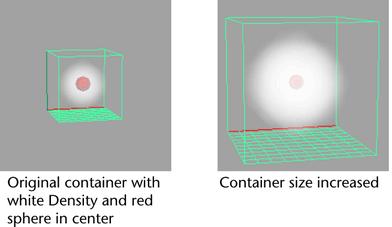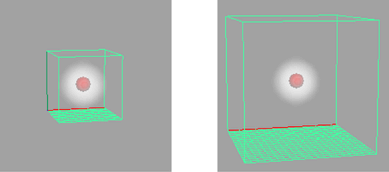You can change the size of fluid containers by:

The dimensions (physical size) of the fluid container are defined in the working units set for Maya. Increasing or decreasing the dimensions of a container while keeping the resolution unchanged increases or decreases the voxel size, respectively.
For example, if you increase the size of a container with Density, the total amount of fluid that appears increases proportionally and the fluid appears thicker than the original.

Scaling fluid containers using the Scale transform increases the size of the container without scaling the properties inside the container.
For example, if you increase the scale of a container with Density, the density appears thinner because the amount of density in each voxel is redistributed to fill the larger voxel size.
Extending container boundaries
You can extend the boundaries of an existing fluid container by adding voxels to any of the sides of the container. This increases the resolution of the fluid (the number of voxels defining the fluid) without affecting the size or the contents of the voxels. (Voxel size is determined by the fluid container size and the initial resolution of the fluid container. To maintain the voxel size while extending the fluid container, Maya scales the fluid container.)
The contents of the voxels remain intact. For properties defined as Gradient, the gradient values are applied to the entire container.
